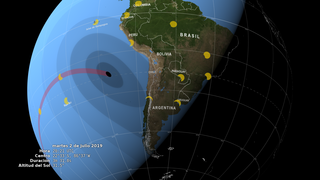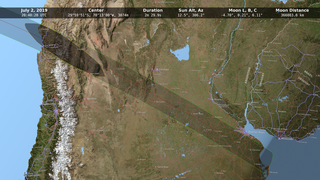Earth
Sun
Planets and Moons
ID: 4713
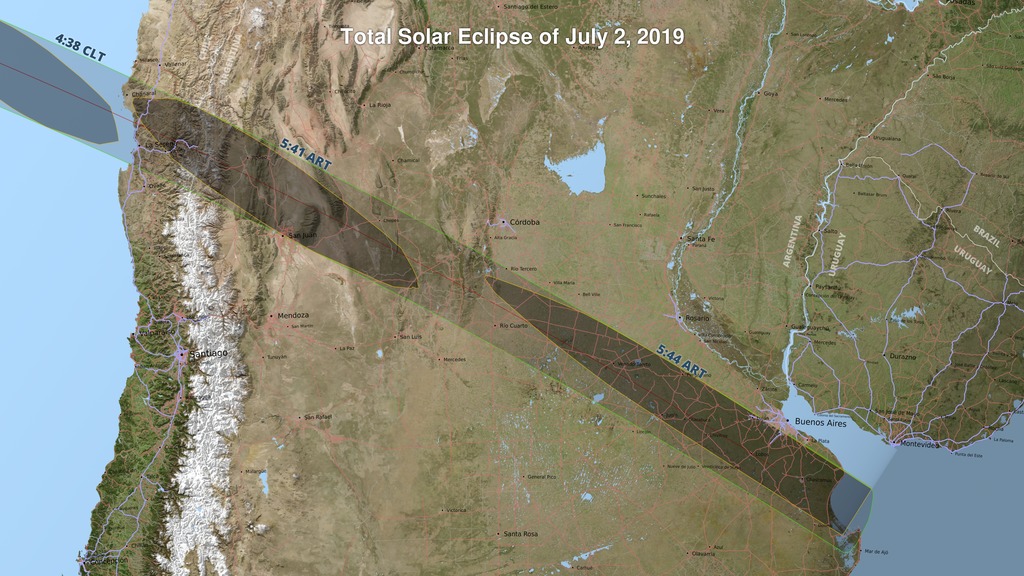
This map of Chile and Argentina shows the path of the Moon's umbral shadow — the path of totality — during the total solar eclipse on July 2, 2019. Features include national boundaries, major roads, and place names. The umbra is shown at 3-minute intervals labeled in the local time zone of the umbra center (Chile or Argentina standard time). To read about the reason the shapes aren't smooth ovals, go here. At 300 DPI, the scale of the map is approximately 1:4,000,000.
The map uses a number of NASA data products. The land color is based on Blue Marble Next Generation, a global mosaic of MODIS images assembled by NASA's Earth Observatory. Elevations are from SRTM, a radar instrument flown on Space Shuttle Endeavour during the STS-99 mission. Lunar topography, used for precise shadow calculations, is from NASA LRO laser altimetry and JAXA Kaguya stereo imaging. Planetary positions are from the JPL DE421 ephemeris. The lunar limb profile and eclipse calculations are by the visualizer.
The map below shows the global extent of the shadow path. The umbra is drawn at 10-minute intervals.
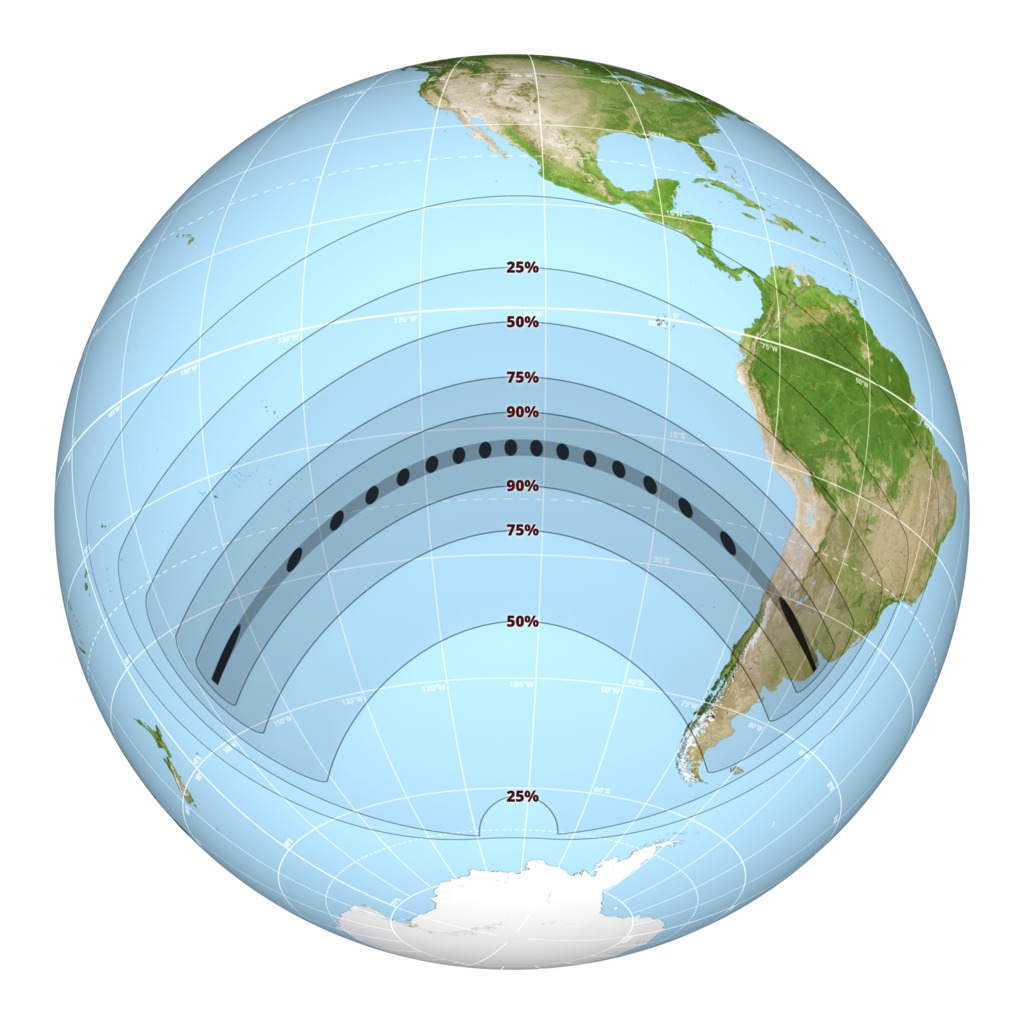
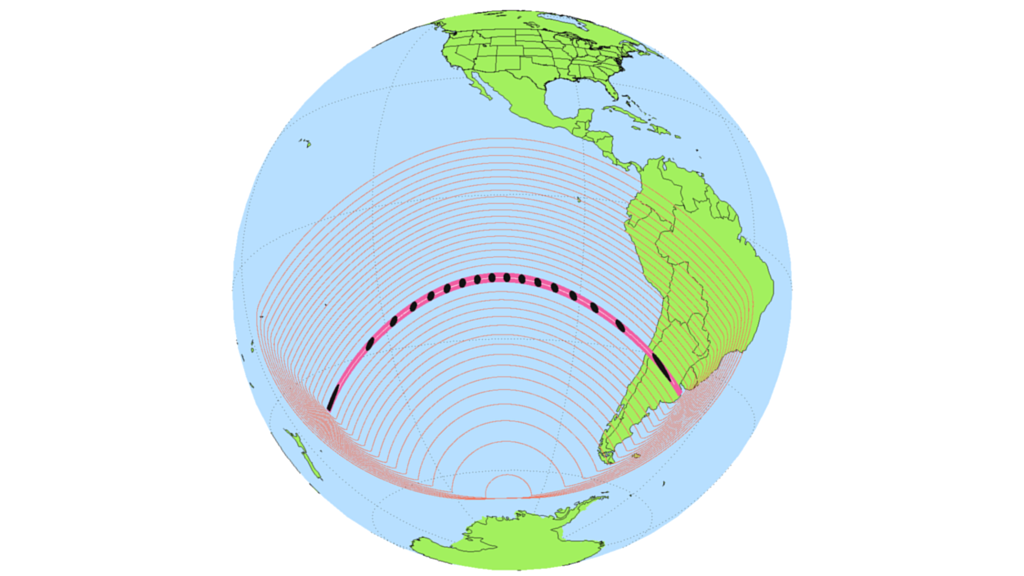
eclipse2019_shapefiles.zip contains the following shapefiles:
penum19 contains the contours for maximum obscuration at 5-percent intervals from 95% to 5%, and the penumbra edge at 0%.
w_upath19 contains the complete path of totality.
w_umbra19_1m contains umbra shapes at 1-minute intervals from 18:02 to 20:44 UTC, covering the complete timespan of totality.
w_center19 contains the complete center line.
The projection for all of these shapefiles is WGS84, latitude-longitude, in degrees. A minimal .PRJ file reflecting this projection is included for each shape.
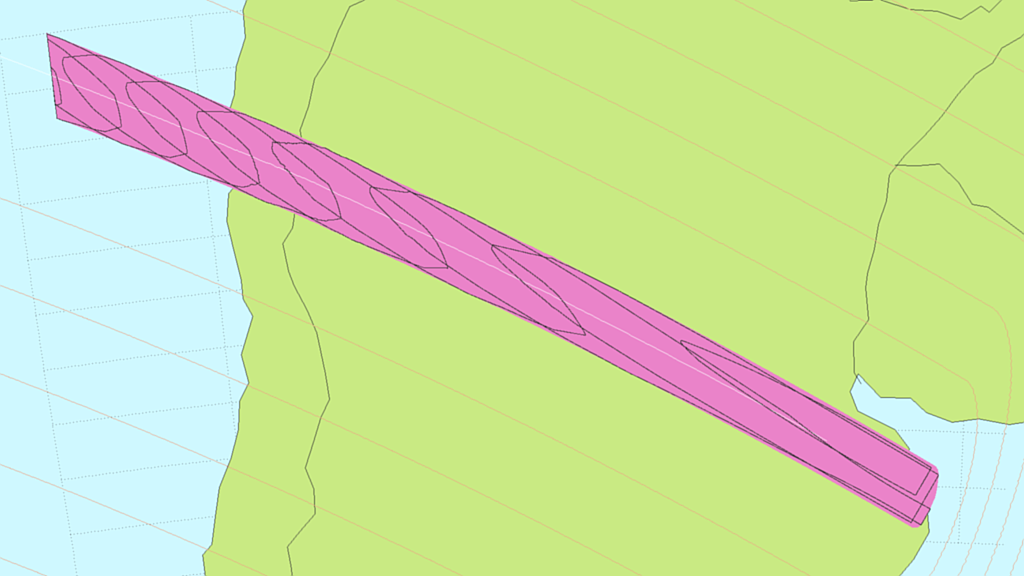
eclipse2019_shapefiles_1s.zip is intended for larger-scale (higher resolution) mapping. It contains the following shapefiles:
umbra19_1s contains 560 umbra shapes at one-second intervals from 20:35:30 to 20:44:49 UTC. These are high-resolution shapes with roughly 100-meter precision. The attributes for each shape include both a string representation of the UTC time and an integer containing the number of seconds past midnight of eclipse day.
upath19 contains the path of totality, limited to the extent of the 560 umbra shapes. Both the path and the umbra shapes are truncated at 75°W.
center19 contains the center line as a polyline with points at one-second intervals.
2019 Total Solar Eclipse Maps and Shapefiles

The map uses a number of NASA data products. The land color is based on Blue Marble Next Generation, a global mosaic of MODIS images assembled by NASA's Earth Observatory. Elevations are from SRTM, a radar instrument flown on Space Shuttle Endeavour during the STS-99 mission. Lunar topography, used for precise shadow calculations, is from NASA LRO laser altimetry and JAXA Kaguya stereo imaging. Planetary positions are from the JPL DE421 ephemeris. The lunar limb profile and eclipse calculations are by the visualizer.
The map below shows the global extent of the shadow path. The umbra is drawn at 10-minute intervals.

Shapefiles
The map was rendered in animation software, but maps are more typically created using geographic information system (GIS) tools and vector datasets. A set of shapefiles describing the umbra and penumbra extents is provided below in two Zip archives, one for small-scale (global) maps and the other for larger-scale mapping.
penum19 contains the contours for maximum obscuration at 5-percent intervals from 95% to 5%, and the penumbra edge at 0%.
w_upath19 contains the complete path of totality.
w_umbra19_1m contains umbra shapes at 1-minute intervals from 18:02 to 20:44 UTC, covering the complete timespan of totality.
w_center19 contains the complete center line.
The projection for all of these shapefiles is WGS84, latitude-longitude, in degrees. A minimal .PRJ file reflecting this projection is included for each shape.

umbra19_1s contains 560 umbra shapes at one-second intervals from 20:35:30 to 20:44:49 UTC. These are high-resolution shapes with roughly 100-meter precision. The attributes for each shape include both a string representation of the UTC time and an integer containing the number of seconds past midnight of eclipse day.
upath19 contains the path of totality, limited to the extent of the 560 umbra shapes. Both the path and the umbra shapes are truncated at 75°W.
center19 contains the center line as a polyline with points at one-second intervals.
Related
Visualization Credits
Ernie Wright (USRA): Lead Visualizer
Laurence Schuler (ADNET Systems, Inc.): Technical Support
Ian Jones (ADNET Systems, Inc.): Technical Support
Genna Duberstein (USRA): Producer
Ernie Wright (USRA): Programmer
Laurence Schuler (ADNET Systems, Inc.): Technical Support
Ian Jones (ADNET Systems, Inc.): Technical Support
Genna Duberstein (USRA): Producer
Ernie Wright (USRA): Programmer
Please give credit for this item to:
NASA's Scientific Visualization Studio
NASA's Scientific Visualization Studio
Short URL to share this page:
https://svs.gsfc.nasa.gov/4713
Data Used:
Note: While we identify the data sets used in these visualizations, we do not store any further details nor the data sets themselves on our site.
Keywords:
SVS >> Moon
SVS >> Solar Eclipse
GCMD >> Earth Science >> Sun-earth Interactions
SVS >> Hyperwall
SVS >> Eclipse
SVS >> Heliophysics
SVS >> Sun-Earth-Moon Interactions
SVS >> Sun and Earth
NASA Science >> Earth
NASA Science >> Sun
NASA Science >> Planets and Moons
SVS >> Map
GCMD keywords can be found on the Internet with the following citation: Olsen, L.M., G. Major, K. Shein, J. Scialdone, S. Ritz, T. Stevens, M. Morahan, A. Aleman, R. Vogel, S. Leicester, H. Weir, M. Meaux, S. Grebas, C.Solomon, M. Holland, T. Northcutt, R. A. Restrepo, R. Bilodeau, 2013. NASA/Global Change Master Directory (GCMD) Earth Science Keywords. Version 8.0.0.0.0
https://svs.gsfc.nasa.gov/4713
Data Used:
SRTM/SIR-C/DEM
Terra and Aqua/MODIS/Blue Marble: Next Generation also referred to as: BMNG
Credit:
The Blue Marble data is courtesy of Reto Stockli (NASA/GSFC).
The Blue Marble data is courtesy of Reto Stockli (NASA/GSFC).
LRO/LOLA/Digital Elevation Map also referred to as: DEM
JPL DE421 also referred to as: DE421
Ephemeris - NASA/JPL
Planetary ephemerides
LRO/SELENE/LOLA/TC/DIgital Elevation Model also referred to as: SLDEM2015
Model
A digital elevation model of the Moon derived from the Lunar Orbiter Laser Altimeter and the SELENE Terrain Camera. See the description in Icarus. The data is here.
Global Roads Inventory Project also referred to as: GRIP4
Database
Roads database covering 222 countries
Credit:
The GRIP4 roads database is provided under an Open Data Commons Open Database License. Meijer, J.R., Huijbegts, M.A.J., Schotten, C.G.J. and Schipper, A.M. (2018): Global patterns of current and future road infrastructure. Environmental Research Letters, 13-064006.
The GRIP4 roads database is provided under an Open Data Commons Open Database License. Meijer, J.R., Huijbegts, M.A.J., Schotten, C.G.J. and Schipper, A.M. (2018): Global patterns of current and future road infrastructure. Environmental Research Letters, 13-064006.
Natural Earth: Cultural Vectors
Natural Earth
Boundaries, populated places
Keywords:
SVS >> Moon
SVS >> Solar Eclipse
GCMD >> Earth Science >> Sun-earth Interactions
SVS >> Hyperwall
SVS >> Eclipse
SVS >> Heliophysics
SVS >> Sun-Earth-Moon Interactions
SVS >> Sun and Earth
NASA Science >> Earth
NASA Science >> Sun
NASA Science >> Planets and Moons
SVS >> Map
GCMD keywords can be found on the Internet with the following citation: Olsen, L.M., G. Major, K. Shein, J. Scialdone, S. Ritz, T. Stevens, M. Morahan, A. Aleman, R. Vogel, S. Leicester, H. Weir, M. Meaux, S. Grebas, C.Solomon, M. Holland, T. Northcutt, R. A. Restrepo, R. Bilodeau, 2013. NASA/Global Change Master Directory (GCMD) Earth Science Keywords. Version 8.0.0.0.0
